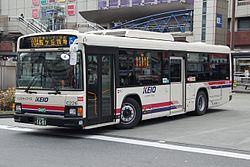Founded 2002 | Fleet 858 | |
 | ||
Stations 10 depots, 2 branch offices Operator Keio Dentetsu Bus Co., Ltd.Keio Bus Higashi Co., Ltd.Keio Bus Chūō Co., Ltd.Keio Bus Minami Co., Ltd.Keio Bus Koganei Co., Ltd. CEO Noriaki Kawasugi (28 Jun 2012–) Fuel types | ||
Keio Dentetsu Bus Co., Ltd. (京王電鉄バス株式会社, Keiō Dentetsu Basu Kabushiki-gaisha) is a core bus-operating company of the Keio Group which was established on February 1, 2002, inherited business all of the Keio Electric Railway (present Keio Corporation) automobile operation division and started business on August 1 of the same year. It has four subsidiaries, Keio Bus Higashi Co., Ltd. (京王バス東株式会社, Keiō Basu Higashi Kabushiki-gaisha), Keio Bus Chuo Co., Ltd. (京王バス中央株式会社, Keiō Basu Chūō Kabusiki-gaisha), Keio Bus Minami Co., Ltd. (京王バス南株式会社, Keiō Basu Minami Kabushiki-gaisha) and Keio Bus Koganei Co., Ltd. (京王バス小金井株式会社, Keiō Basu Koganei Kabushiki-gaisha) (This article treats also about these subsidiaries). The head office of these companies is located in Fuchu, Tokyo, Japan. The operating area of a general bus on a regular route is mainly the Tokyo Tama area and if the management commission route to each subsidiary company is included, the operating area is reached mostly whole region along all areas along the Keio railroad lines. Moreover, it operates around the expressway bus routes to Nagano Prefecture, Hida-Takayama, Miyagi Prefecture, etc. from Shinjuku.
Contents
History
The history of the bus of Keio starts for the Keio Denki Kidō Co. to have opened the bus on April 15, 1913 in the section where the railroad is not opened for traffic (between Shinjuku Station - Sasazuka Station and between Chōfu Station - Fuchū Station - Kokubunji Station). Although these were the first bus business in Tokyo, the tone of the provisional means of transport was deep, and canceled between Chōfu Station - Kokubunji Station in 1914, between Shinjuku Station - Sasazuka Station was abolished with railroad commencement of business in 1915, and all have taken down the curtain for a short period of time.
Keio sets about a bus enterprise in early stages of Shōwa period again. Banzai Jidōsha Co.(万歳自動車) which operated around the bus from the end of Taishō period changed the company name to the Kōshū Kaidō Noriai Jidōsha Co.(甲州街道乗合自動車) in July, 1924, and the route was extended to Tama-mura Tokyo city-owned park cemetery (present Tama Cemetery) through Karasuyama and Chofu. However, Keio which has a railroad in parallel to the Kōshū Kaidō felt this as the threat, and made more than the majority of the holdings of the company acquisition and an associated company in May, 1927. Furthermore, the Keio acquired Kōshū Kaidō Noriai Jidōsha in 1937, and absorbed enterprise all. Thereby, the automobile division and Sasazuka office were installed and the bus enterprise of the direct management which leads to the present Keio Dentetsu Bus Group was resumed. Hachiōji Shigai Jidōsha Co.(八王子市街自動車) was purchased and the Hachioji Office was established in 1938. Moreover, Takahata Noriai (高幡乗合) is purchased in the same year, Yugi Noriai Jidōsha (由木乗合自動車) was purchased in 1939, and these enterprises were absorbed. The Pacific War broke out and the route within Yamanote Line was transferred to Tokyo City on February 1, 1942 for the war integration based on a land transport business method of preparation. Moreover, the Keio came to be merged by Tokyu Corporation on May 31, 1944 (Keio Teito Electric Railway dissociated from Tokyu in 1948).
Depots
Head Office of Keio Dentetsu Bus and its subsidiaries - 2-22, Harumichō, Fuchu, Tokyo, Japan
Regular routes
Operators:Community Bus routes
Cars
The vehicles introduced from four manufacturers, Hino, Isuzu, Mitsubishi Fuso and Nissan Diesel, are held into the Keio Dentetsu Bus Group. Although the general route vehicle is introduced from all these four manufacturers, the rate of the Nissan Diesel vehicles is slightly high. The reason is that the one-step vehicles with narrow width and long body (Nissan Diesel JP) were purchased in lump sum from Nissan Diesel in advancing low floor-ization of vehicles in the mid-1990s.
